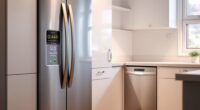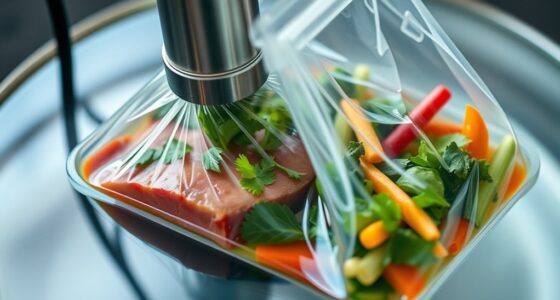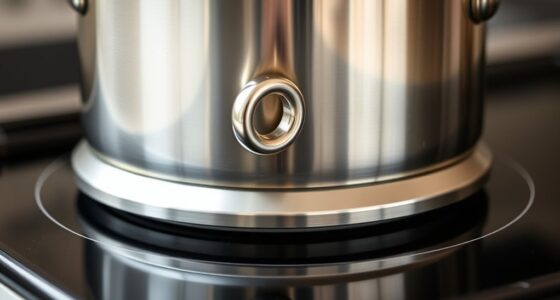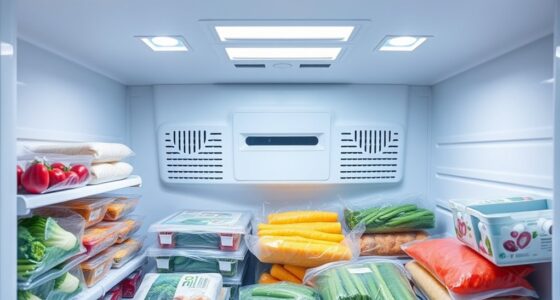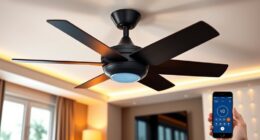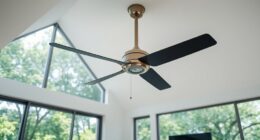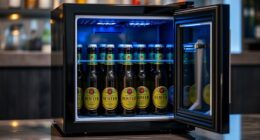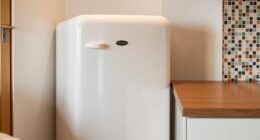Ducted range hoods generally offer higher capture efficiency because they vent fumes, smoke, and airborne particles directly outside, preventing indoor buildup. Ductless hoods depend on filters to trap odors and pollutants, which can lessen their effectiveness over time. Factors like kitchen size, layout, and proper maintenance also influence performance. If you want to maximize pollutant removal and indoor air quality, understanding these differences can help you pick the best option for your kitchen.
Key Takeaways
- Ducted hoods typically offer higher capture efficiency by venting fumes and pollutants directly outside, preventing indoor buildup.
- Proper duct design, including size and minimal bends, enhances airflow and pollutant removal efficiency in ducted systems.
- Ductless hoods rely on activated carbon filters, which neutralize odors but have lower efficiency in capturing airborne particles and fumes.
- Higher airflow rates (200-350 CFM) in ducted hoods improve pollutant removal but require proper installation for optimal capture.
- Regular maintenance of filters and system components is critical to sustain capture efficiency in both ducted and ductless hoods.
How Ducted Range Hoods Maximize Pollutant Removal

Ducted range hoods are highly effective at removing cooking pollutants because they vent fumes, smoke, and airborne particles directly outside your home. This outdoor venting prevents indoor accumulation of harmful gases like nitrogen dioxide (NO2), carbon monoxide (CO), and fine particles (PM2.5). Higher airflow rates, typically between 200-350 CFM, enhance pollutant removal by quickly clearing the air. Larger, deeper hoods with full coverage over the cooktop improve capture efficiency by containing emissions before they disperse. Proper hood height and open bottom designs maximize airflow and pollutant capture, while optimized duct design ensures consistent airflow velocity. These design factors, combined with higher ventilation rates, markedly reduce indoor pollutant levels, leading to cleaner air and healthier indoor environments during and after cooking. Effective venting also helps prevent grease buildup on kitchen surfaces, maintaining cleanliness and reducing fire hazards. Additionally, selecting a properly installed duct system is crucial to ensure maximum efficiency and minimize air leaks that could reduce pollutant removal effectiveness. When considering airflow velocity, it’s important to note that maintaining the right balance can significantly improve pollutant capture and overall ventilation performance.
The Role of Filters in Ductless Range Hood Performance
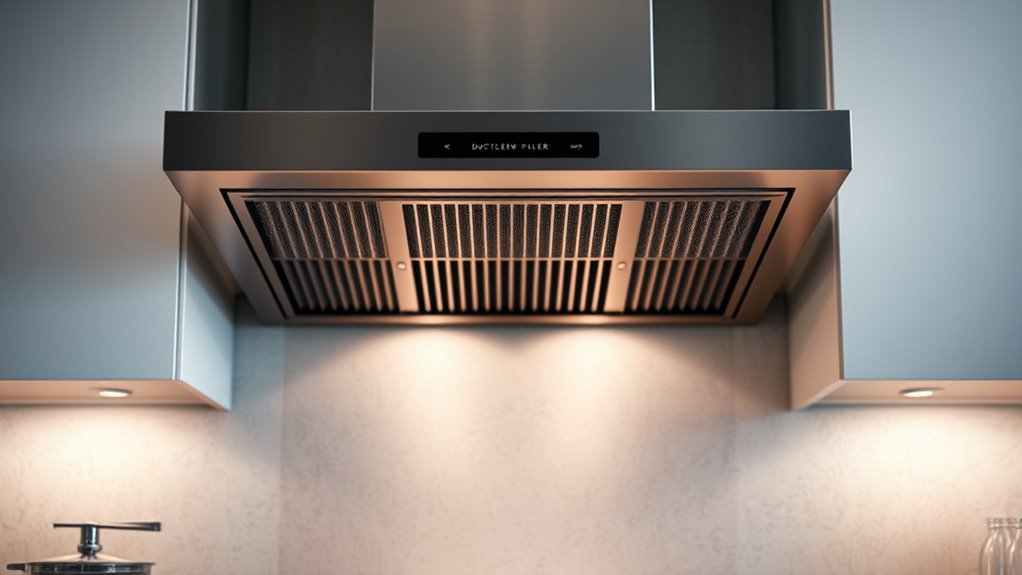
Filters are essential for ductless range hoods to effectively clean your kitchen air. Different types like baffle, mesh, and charcoal serve distinct roles in trapping grease and neutralizing odors. Regular maintenance and understanding their functions help make sure your hood performs at its best. Proper filter maintenance is crucial for ensuring optimal airflow and extending the lifespan of your range hood. Additionally, selecting the appropriate filter type can significantly impact the overall capture efficiency of your ventilation system. Incorporating recycled materials into filter production can also promote sustainability and reduce environmental impact.
Filter Types and Effectiveness
In ductless range hoods, the effectiveness of air purification primarily depends on the types of filters used and how well they perform their roles. Typically, these hoods incorporate activated carbon (charcoal) filters to trap odors and VOCs through adsorption, neutralizing gases rather than trapping them physically. Aluminum or metal mesh layers work alongside to capture grease and larger particles, preventing buildup inside the unit. Some models add polymer filters for multi-stage filtration, enhancing overall performance. The combination of grease-trapping and odor-neutralizing filters ensures extensive air treatment. However, since ductless systems rely on recirculation, their ability to eliminate odors is limited compared to vented systems. The quality of filters and timely replacements are vital to maintaining ideal filtration and air freshness.
Maintenance and Replacement Schedule
Maintaining the effectiveness of your ductless range hood depends heavily on sticking to a regular schedule for replacing and cleaning filters. Charcoal filters should be replaced every 6 to 12 months, but heavy cooking may require replacements every 3 to 6 months to ensure odor absorption remains effective. Grease and particulate filters need weekly or bi-weekly cleaning to prevent buildup that impairs airflow. Monthly visual inspections help catch damage or clogging early, while deep cleaning every six months extends the hood’s lifespan. Cooking habits influence maintenance frequency; frequent frying accelerates filter clogging, demanding more attentive care. Additionally, scheduling annual or bi-annual professional inspections can identify hidden issues, ensuring your hood functions efficiently and lasts longer. Proper filter maintenance contributes significantly to overall air quality and device longevity.
Impact on Air Quality
Activated carbon filters play a crucial role in how effectively your ductless range hood improves indoor air quality. They trap odors and pollutants, neutralizing cooking fumes, grease, and smell particles. Since these filters don’t vent air outside, they rely on chemical adsorption to reduce odors, making them ideal for kitchens without ductwork. Most filters combine aluminum layers to trap grease and grime with charcoal layers that target gases and odors. Regular filter replacement every few months is essential to maintain their performance. While they improve air quality by recirculating filtered air, they can’t remove moisture or ultrafine particles. Consequently, some odors and pollutants may linger or escape, especially if filters become clogged or aren’t maintained properly. Proper filter care is key to maximizing air quality benefits. Additionally, the effectiveness of these filters can be enhanced by selecting models with high-quality activated carbon, which can adsorb more contaminants and extend the filter’s lifespan. Using filters with advanced filtration materials can further improve their ability to capture a broader range of pollutants.
Comparing Noise Levels and Power Consumption
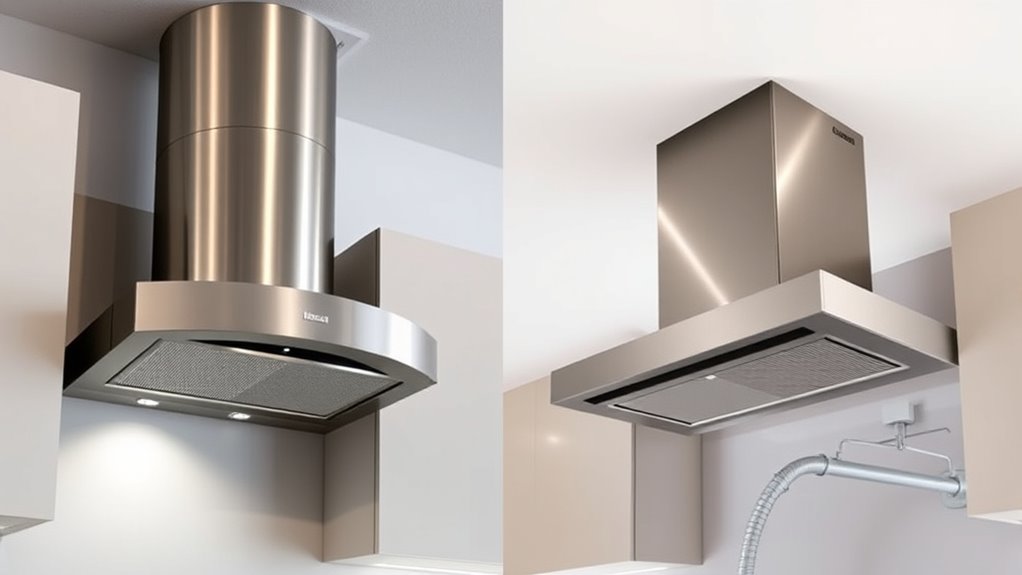
When choosing between ducted and ductless range hoods, noise level and energy consumption are key factors to contemplate. Ductless models tend to be louder and use more power because they recirculate air through filters, while ducted units operate more quietly and efficiently. Understanding these differences helps you select a system that balances comfort and energy savings for your kitchen. Additionally, eye patch benefits can be a useful analogy when considering the importance of targeted performance and comfort in appliance choices. Incorporating features that enhance digital literacy at home can also contribute to more informed and conscious appliance selections, especially as technology continues to advance.
Noise Levels and User Comfort
Ducted range hoods typically operate more quietly than ductless models because their fans are positioned farther from the kitchen and vent outside, reducing noise levels. This setup lowers audible disturbance during cooking. Ductless hoods, with integrated fans inside the unit, require more power to filter and recirculate air, which increases noise. Noise levels are often measured in sones, with ducted hoods tending to be quieter at 6-7 sones compared to ductless models. Here’s what to contemplate:
- Ducted hoods produce less noise due to outside venting.
- Ductless models generate continuous noise from filters and recirculation.
- Larger ducts in ducted hoods can help reduce operational noise.
- User comfort improves with quieter ducted options, especially in open layouts.
- The energy efficiency of ducted systems can also influence overall noise and power consumption.
- Proper installation planning can optimize noise reduction and energy use, enhancing user experience.
Energy Use and Efficiency
While both ducted and ductless range hoods serve to improve kitchen air quality, their energy consumption patterns differ considerably. Ducted models typically use more energy because their powerful fans push air through ductwork outside. Ductless units consume less, as their fans circulate air locally, but continuous recirculation via filters can increase power use depending on filter cleanliness. Higher CFM ratings in ducted hoods boost efficiency but also raise energy consumption. Proper maintenance is essential: clogged filters in ductless hoods increase fan load, while duct leaks in ducted systems demand more energy.
| Feature | Impact on Energy Use |
|---|---|
| Ducted Fans | Higher power, more HVAC load |
| Ductless Fans | Lower power, filter-dependent |
| Filter Maintenance | Affects ductless efficiency |
| Duct Leaks | Increase ducted system energy |
| Fan Speed Settings | Optimize energy use |
Impact of Kitchen Layout and Size on Capture Efficiency
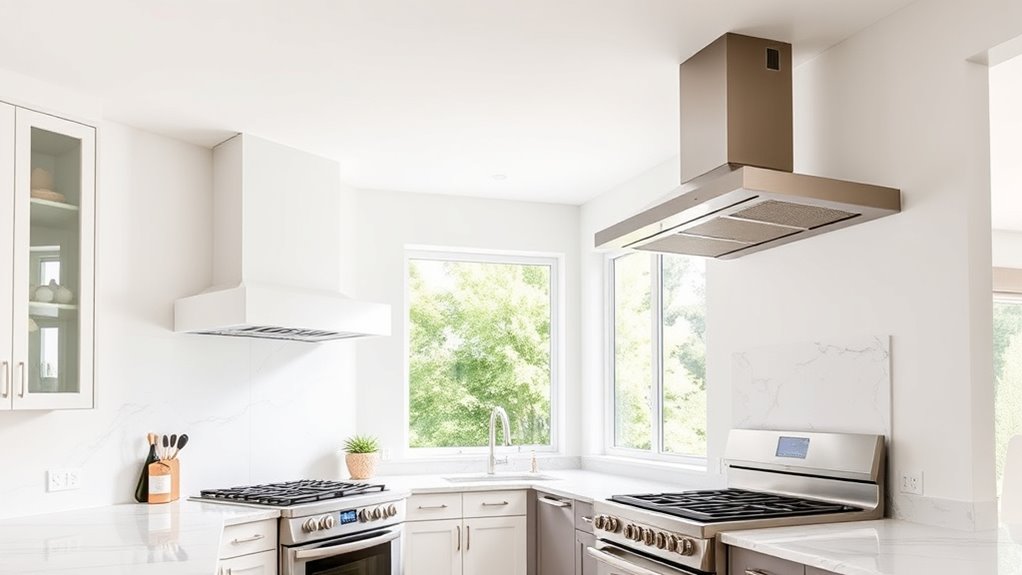
The size and layout of your kitchen directly influence how effectively your range hood captures smoke, steam, and odors. Larger, open-concept kitchens demand more powerful hoods to handle the increased air volume. Smaller kitchens benefit from compact, well-matched hoods that cover the cooktop adequately. Proper hood extension beyond the cooking surface guarantees full coverage of emissions. Keep in mind, higher airflow rates don’t always mean better capture; sizing relative to your kitchen’s volume is key. Additionally, cooking activities like high-heat frying require more ventilation. The placement of your hood matters too—ideally, it should be 12–18 inches above the cooktop, with precise positioning to prevent airflow disruptions. Proper design ensures contaminants are effectively captured, regardless of your kitchen’s size or layout. Understanding ventilation strategies can further enhance your hood’s efficiency and safety.
Maintenance Requirements and Their Effect on Performance
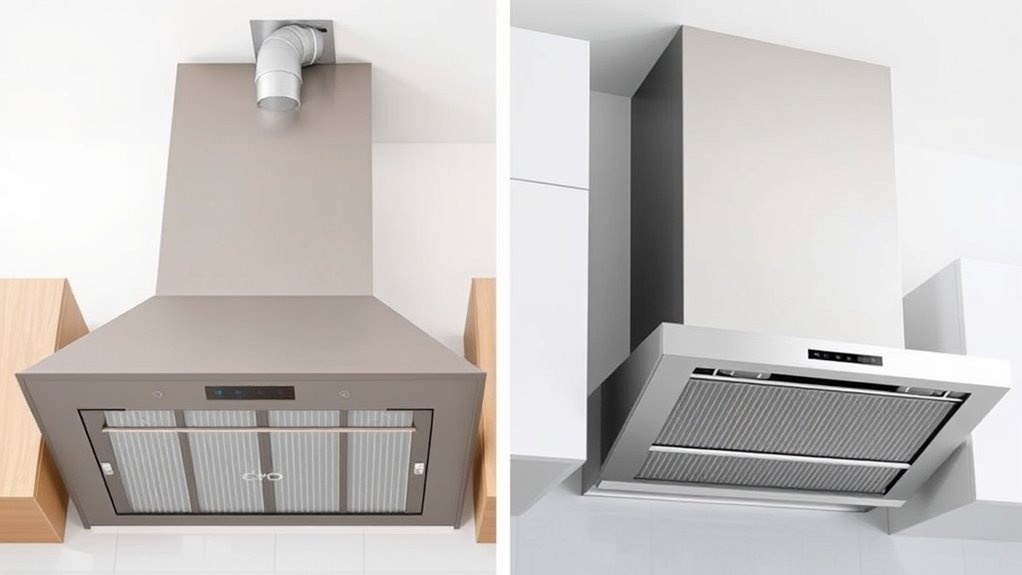
Proper maintenance of your range hood is essential to keep it working at peak performance. Regularly cleaning filters prevents grease and particle buildup that block airflow. Metal filters need cleaning every 30 hours of use, usually monthly or bi-monthly, while charcoal filters should be replaced roughly every two months. Neglecting filter maintenance reduces suction power, strains the motor, and decreases overall efficiency. Ducted systems require annual duct inspections to prevent blockages and leaks, which can lower airflow and increase noise. Motor and fan maintenance, including cleaning blades and lubricating bearings, ensure ideal suction and reduce energy use. Keep exterior vents clear of debris and check dampers regularly to maintain airflow. Additionally, air purifier maintenance plays a crucial role in ensuring optimal indoor air quality, especially in environments with high pollution levels. Regular inspections and timely filter replacements help maintain capture efficiency, directly impacting the system’s ability to remove airborne contaminants effectively. Consistent maintenance directly impacts capture efficiency, prolongs system life, and keeps your kitchen safer.
Indoor Air Quality Benefits of Ducted vs. Ductless Systems
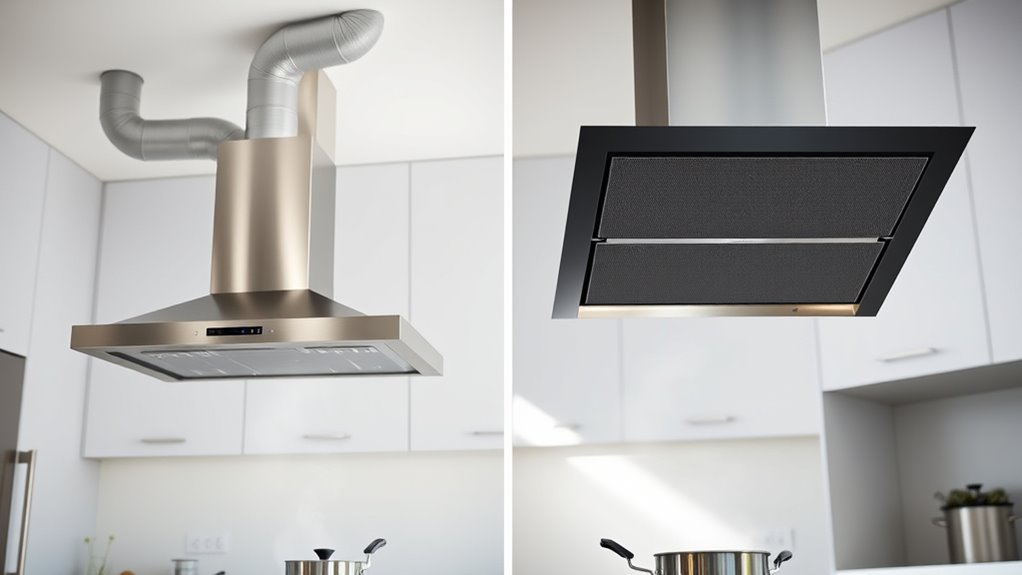
Ducted range hoods deliver superior indoor air quality by venting smoke, odors, steam, and airborne grease directly outside, effectively removing contaminants from your kitchen. This prevents buildup of humidity and heat, which can worsen air quality. Ductless hoods filter air with charcoal and mesh filters but recirculate it indoors, removing fewer pollutants and odors. They also tend to increase indoor humidity and heat levels, potentially fostering mold growth and discomfort. Additionally, ductless filters require regular maintenance; clogged filters reduce efficiency. Noise levels can be higher in ductless systems due to internal fans, possibly discouraging full operation. Overall, ducted systems consistently improve air quality, especially in sensitive environments, by effectively removing pollutants and controlling moisture and temperature. Automation technology is increasingly being integrated into smart kitchen appliances to optimize ventilation performance and energy efficiency. Furthermore, the choice between ducted and ductless systems can significantly impact indoor air quality, making it a critical consideration for health-conscious homeowners.
Practical Considerations for Installation and Space Constraints
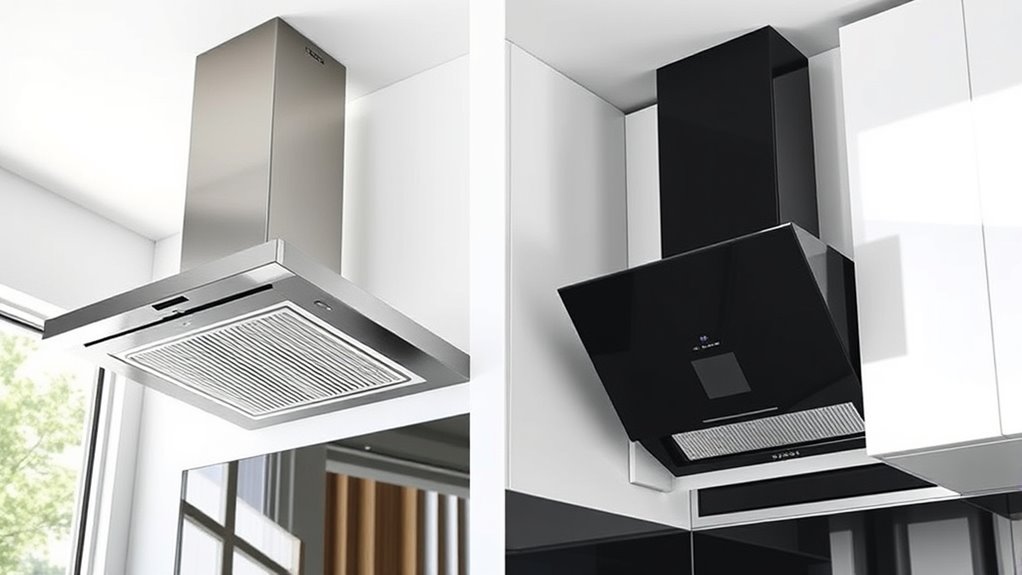
When installing a range hood, understanding the structural and space requirements is essential for a smooth process. Ducted hoods need an exterior vent hole, which can be labor-intensive and may impact your home’s appearance. Installing ductwork involves measuring carefully and securing rigid metal ducts to prevent leaks and obstructions. Ductless hoods are simpler to install, requiring only electrical wiring and mounting, with minimal structural changes. Space constraints also matter: ducted units need enough clearance for duct runs, avoiding bends that reduce efficiency, and may require cutting openings in cabinets or walls. Ductless models are more flexible in tight spaces. Proper support with sturdy mounting points and sealants guarantees safety and efficiency. Planning the venting path carefully helps maximize performance and minimizes installation challenges. Additionally, selecting the appropriate venting options can significantly influence the overall effectiveness of your range hood. Considering the cost implications of different venting setups can help you make an informed decision that balances installation complexity and long-term efficiency.
Choosing the Right Range Hood Based on Your Cooking Environment
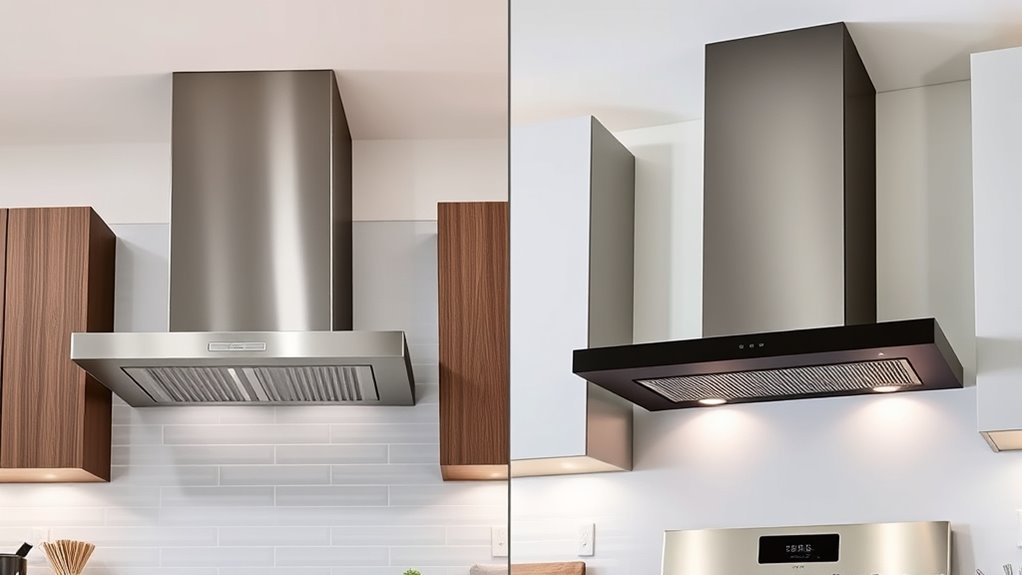
Choosing the right range hood depends on your cooking habits and environment. If you do a lot of frying, searing, or cook with high moisture, a ducted hood is ideal because it fully removes smoke, odors, and grease outside. For lighter cooking or occasional use, a ductless hood can suffice, filtering air and recirculating it back into your kitchen. In humid climates, ducted systems help expel moisture, maintaining a drier space. If duct installation is challenging, ductless models offer flexible placement. Consider allergy or medical needs, as ducted hoods remove more airborne allergens.
- Heavy cooking favors ducted systems for better removal.
- Light cooking may be well-suited for ductless units.
- Humid climates benefit from ducted ventilation.
- Limited space or duct restrictions lean toward ductless options.
Frequently Asked Questions
How Does Duct Size Influence Overall Capture Efficiency?
Duct size directly impacts your range hood’s capture efficiency. If the duct is too small, it restricts airflow, making it harder to vent smoke and fumes effectively, and can increase noise. On the other hand, oversized ducts may weaken static pressure, reducing exhaust power. To optimize performance, choose a duct size that balances airflow volume and static pressure, following manufacturer guidelines for your hood’s CFM rating.
Can a Ductless Hood’s Filters Be Upgraded for Better Performance?
Yes, you can upgrade a ductless hood’s filters for better performance. Many manufacturers offer replacement or upgrade kits with higher-quality activated charcoal and multi-layer filters that trap more odors, grease, and particles. Guarantee the filters are compatible with your model, and replace them regularly—typically every 6 to 8 months—to maintain peak odor removal and airflow. Upgrading filters improves your hood’s efficiency but won’t match the performance of ducted systems.
Do Ducted Hoods Require Special Venting Materials or Insulation?
Yes, ducted hoods require specific venting materials and insulation. You should use rigid galvanized steel or metal HVAC ducts, avoiding flexible plastic ones for durability and safety. Insulate ducts passing through unconditioned spaces to prevent condensation, maintain airflow, and improve efficiency. Proper sealing with foil tape or caulk is essential to prevent leaks. Following local building codes ensures you’re using the right materials and installation practices for the best performance.
How Does Cooking Style Affect the Choice Between Ducted and Ductless Hoods?
Your cooking style determines whether you should choose a ducted or ductless hood. If you do high-heat, greasy, or strong-odor cooking, ducted hoods are better because they remove contaminants efficiently. For lighter, steam-based, or infrequent cooking, ductless hoods work well, especially if venting options are limited. Consider your typical dishes and cooking intensity to pick the system that keeps your kitchen air clean without unnecessary energy use.
What Are the Energy Costs Differences Over Time Between Both Systems?
You might think costs are straightforward, but over time, ductless hoods can surprise you with higher filter replacements and maintenance, adding to ongoing expenses. Ducted systems, while pricier upfront, tend to use more energy during operation and could increase your energy bills. Yet, they often require less regular upkeep. The real difference lies in how each system impacts your home’s overall energy use, shaping your long-term savings or costs.
Conclusion
Ultimately, choosing between ducted and ductless range hoods isn’t just about features—it’s about what your kitchen demands and how each system adapts to your space. Will you prioritize maximum pollutant removal or convenience? The decision could shape your indoor air quality in ways you haven’t yet considered. Stay tuned, because the best choice might surprise you, revealing hidden benefits that could transform your cooking experience in ways you never expected.

